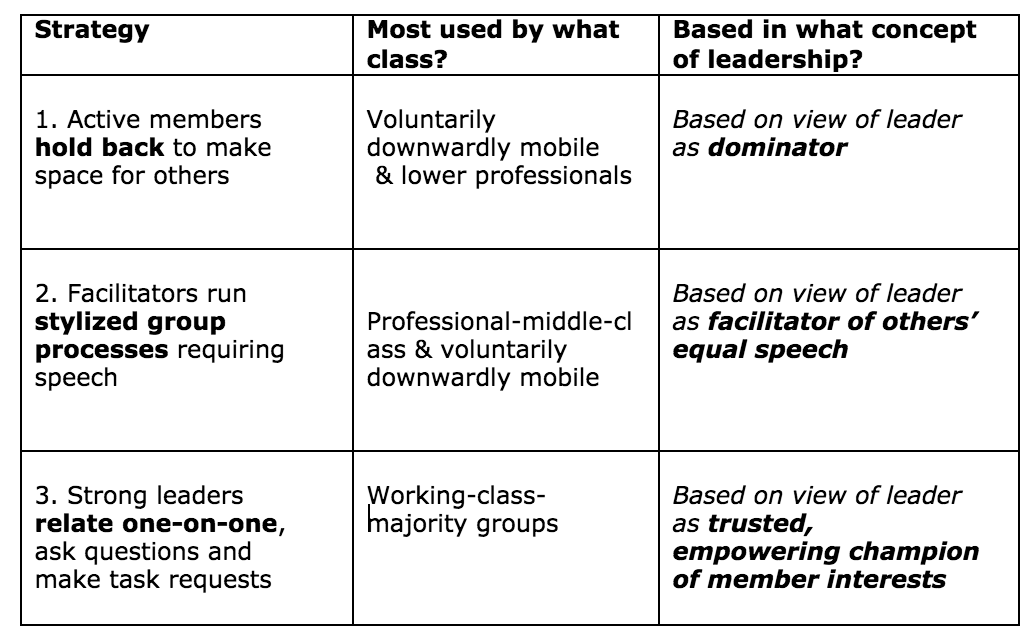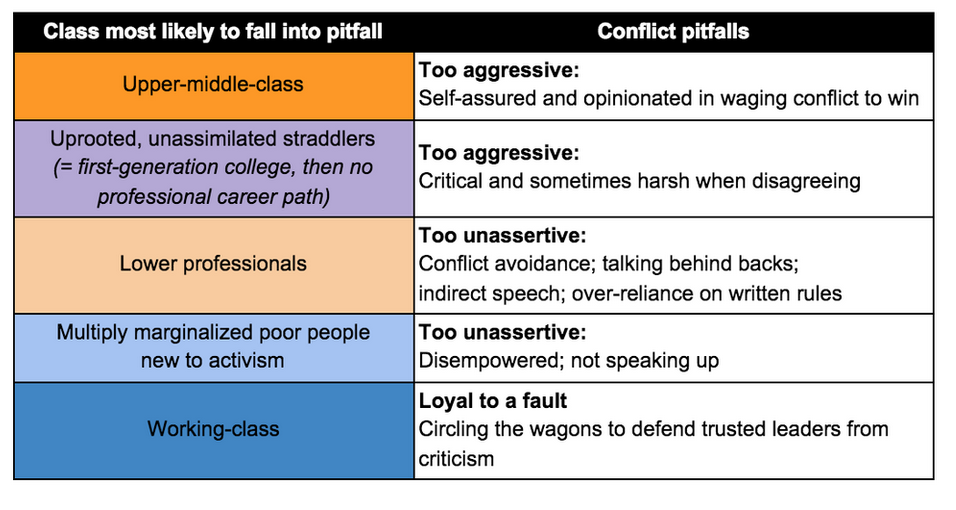









Start a Group
DISCUSSION GUIDE ON ACTIVIST CLASS CULTURES
Start a Group
DISCUSSION GUIDE ON ACTIVIST CLASS CULTURES
Want to discuss these ideas about activist class cultures with a group?
To help you make that happen, here's a tip sheet and a discussion guide for seven sessions, with videos and short readings to review ahead of time (and chapters of Missing Class for book groups).
Here’s a suggested sequence of 7 sessions for a group using this website to spark discussions of activist class cultures. (You can also use this guide for a book group on Missing Class.)
Scroll to session:

Session 1
YOUR CLASS PATH & SOCIAL JUSTICE WORK
Session 1
YOUR CLASS PATH & SOCIAL JUSTICE WORK
AHEAD OF TIME:
1. Watch the opening video.
2. Take the quiz "What's your class path? (below)
(3. For a book group, read Missing Class introduction and chapters 2 and 3.)
AT SESSION 1:
Make agreements on ground-rules for the group. Plan upcoming sessions.
Go-around: What has your class path been? Do one of the “paths” fit your story, and how do you feel about the class identity term that the flow chart gives you? How has your class experience affected your approach to social justice?
Open discussion: How do you think class differences play out in social justice groups?
Scroll to session:

Session 2
ACTIVIST CLASS CULTURES AND MOVEMENT TRADITIONS
Session 2
ACTIVIST CLASS CULTURES AND MOVEMENT TRADITIONS
AHEAD OF TIME:
1. Take the Class Culture Traits Quiz (below).
2. Read about Movement Traditions and look at photos of activist groups by clicking here.
(3. For a book group, read chapters 1 and 4 of Missing Class.)
AT SESSION 2:
Read aloud this memory visualization of a mixed-class activist setting with listeners’ eyes closed if comfortable with that; discuss what cultural differences you noticed between classes.
Discuss the movement traditions that social justice groups you know do or don’t fit into. What’s their class composition and internal culture?
Take the Class Cultures Traits Quiz
Scroll to Session:

Session 3
CLASSED SPEECH AND TALK OF CLASS
Session 3
CLASSED SPEECH AND TALK OF CLASS
AHEAD OF TIME:
1. Watch video or listen to podcast "Pretense, Putdowns and Posing"
2 Read the article "Pretense, Putdowns and Missing Identities in Activists' Class Talk"
3. Watch short animated video "Class Speech Differences"
(4. For a book group, read “Class Speech Differences” interludes I, II, IV and VI from Missing Class.)
FACILITATOR PREPARATION:
Print out handout called “Noticing Class Speech-Style Differences” and fold it so only the top half shows.
AT SESSION 3:
- Look at two quotes from members of the same group; what differences do you notice? Then read their class stories. Discuss.
- Discuss the language style of social justice organizations you support. For example, look at the vocabulary in their mission statements. Does it include the best of both class speech codes?
- Discuss the article / interview video on pretense and posing. Have you ever seen privilege used as a putdown? Have you ever met activists who pretend to be a working-class or poor person when they’re not? Why does the author advocate open talk of class identities?
watch "class speech differences"
Read the article: "Pretense, Putdowns and Missing Identities in Activists' Class Talk"

Session 4
ACTIVATING THE INACTIVE, LEADERSHIP & GROUP PROCESS
Session 4
ACTIVATING THE INACTIVE, LEADERSHIP & GROUP PROCESS
AHEAD OF TIME:
1. Watch the animation "Activating the Inactive" (below) and look at table. Think about which of the strategies you've seen used.
(2. For a book group, read Chapter 6 of Missing Class.)
AT SESSION 4:
1. Which of the three strategies have you used, or seen used? Discuss their pros and cons.
2. Go around and share your values about leadership in social justice efforts. Do they line up with your class path?
Watch "Activating the Inactive"
Which of these strategies have you used?
Scroll to session:

Session 5
ACTIVATING THE INACTIVE, LEADERSHIP & GROUP PROCESS
Session 5
ACTIVATING THE INACTIVE, LEADERSHIP & GROUP PROCESS
AHEAD OF TIME:
1. Watch "Circling the Wagons" animated video.
2. Go over Conflict Pitfalls table below. Think about which pitfalls you've seen.
(3. For book group, read Chapters 8 and 9 and Class Speech Differences V in Missing Class.)
AT SESSION 5:
Go-around: What conflicts have you seen handled well and badly in social justice groups? How did the unproductive responses match the chart or contradict it?
Group discussion: Conflict always arises. How do you feel conflict should be handled in social justice groups for best results?
WATCH "CIRCLING THE WAGONS"
WHICH PITFALLS HAVE YOU SEEN?
Scroll to session:

Session 6
Diversity ironies; What would class-inclusive anti-racism look like?
Session 6
Diversity ironies; What would class-inclusive anti-racism look like?
Ahead of time
1. Watch "Diversity Ironies" animation (below).
2. Read brief article “What would Class-Inclusive Anti-Racism look like?”
3. Go over Diversity Ironies table (below) and think about which approaches to racism you've encountered.
(4. For a book group, read Chapter 7 and Class Speech Differences III in Missing Class. )
AT SESSION 6:
1. Individual writing exercise on a paper with two columns:
• In the left column, list any experiences of diversity workshops and other awareness-raising events on racism and/or other oppressions (excluding school courses); if you know the education levels and occupations of the educators or facilitators and the partiicpants, note that here too.
• In the right column, based on the “class-inclusive anti-racism” article and based on what you now know about class culture differences in speech styles, group process preferences, approaches to conflict, etc., characterize those workshops and event by their predominant class culture.
2. Pairs: take turns sharing what you wrote in your columns, or why it was hard to fill them in.
3. Whole group discussion: Do the experiences of group members mainly confirm or contradict Class Action’s belief that today’s ways of consciousness-raising about racism are permeated with college-educated people’s class culture? What do you think more class-inclusive anti-racism education would look like?
Watch "Diversity Ironies"
Read article: "What would Class-Inclusive Anti-Racism look like?"
which approaches to racism have you encountered?
Scroll to session:

Session 7
CROSS CLASS MOVEMENT BUILDING
Session 7
CROSS CLASS MOVEMENT BUILDING
AHEAD OF TIME:
1. Read about the winners of the Cross-Class Bridge Builder Awards, nominated and voted by people in their local areas. Think about what cross-class organizations you've been impressed by.
2. Watch video of Laura Flanders interviewing Betsy Leondar-Wright.
(3. For a book group, read the Conclusion of Missing Class.)
AT SESSION 7:
- What local organization(s) would you nominate for the Cross-Class Bridge Builder Award? What support can you give the organization(s)?
- What are your action steps to apply what you’ve learned in this Discussion Group? Write privately, then share in pairs; consider setting up accountability check-ins with your pair buddy.
- Share individual action steps and discuss.
- Is this group now over, or are you making plans to continue? Plan - or thank each other and say farewell.
- Fill out the online evaluation form to enable Class Action to keep improving this Discussion Group Guide and the Activist Class Cultures online kit. - [link]
Think about what cross-class organizations you've been impressed by.
Watch video of Laura Flanders interviewing Betsy Leondar-Wright
Scroll to session:

Glossary
Glossary
The U.S. has no hard and fast divisions between classes. Some people grow up in one class and live as adults in another, traveling a mobile class path. For immigrants, their class status in their country of origin is often different from their class status in the U.S. Nevertheless, it can be useful for understanding class dynamics to clump people roughly into these categories of class paths:
Definitions of class paths
Persistent poverty: Less than high school education; relying on public assistance or erratic low-paid work outside mainstream labor market; so low-income that basic needs unmet; public or substandard housing or homeless.
Working class: High school degree and sometimes vocational education; supervised wage jobs or hands-on small business; renting or modest homeownership.
Subcategories: Lower-middle-class; working poor
Professional-middle class: 4-year college degree or more; professional/managerial jobs with relatively more autonomy and often higher income and security; homeownership trading up to bigger homes.
Subcategories: Lower-professionals; upper-middle-class.
Owning class – Enough assets and investment income that paid work is not essential between ages 22 and 65; elite private schools and colleges; often multiple homes or luxury homes.
MOBILE CLASS PATHS:
Straddler: Upwardly mobile from working-class or poor childhood, first generation college degree; having or seeking a professional career (assimilated straddler) or not (unassimilated straddler)
Voluntarily downwardly mobile: From professional-middle-class or upper-middle-class background, college degree, then choices not to pursue professional career due to political, artistic or environmental values.
Involuntarily downwardly mobile: From professional-middle-class or upper-middle-class background, impacted by health crises and disabilities, addictions, crashed economy, war or other traumas, so in poverty or working class as an adult.
Mixed class: Many people have complicated stories that don’t fit into one of these categories.
Throughout this site, class paths are marked with colors.
Class Definitions
Class: relative rank in terms of income, wealth, education, status, and/or power.
Class background: Class life experience during formative childhood years
Class path: Class background plus adult class; upward or downward mobility or staying in the same class
Classism: the institutional, cultural, and individual practices and beliefs that assign different value to people according to their class; and the economic system that creates excessive inequality and causes basic human needs to go unmet. Classism is woven together with racism and other systems of inequality.









